What happened to England's lost football grounds?
- Published

Middlesbrough, seen here in action against Leyton Orient in 1978, played at Ayresome Park until 1995
West Ham United are due to move to the Olympic Stadium in Stratford from Upton Park in 2016 while Tottenham Hotspur, who have plans for a new stadium next to their current White Hart Lane ground, will have to find a temporary home venue for the 2017-18 season.
They are just the latest clubs to leave their long-established homes - a trend which began in the 1990s and which shows no signs of abating.
So what became of England's lost football grounds?

Arsenal: Highbury. Closed in 2006
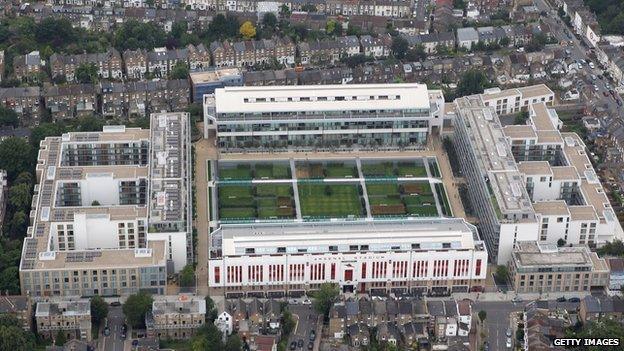
The facades of the old East and West Stands were preserved
There are hundreds of flats around the old Highbury pitch and John Jeans lives in one with a view of the famous turf from the old North Bank.
However, while this is a dream for many Arsenal fans, Dr Jeans has slightly mixed feelings about it. He is a Chelsea fan.
"I did say to my wife we'd never live at Highbury," he said. "But a year and a half later, because of the practicality (of it), we ended up moving there."
"The Arsenal fans, they like to point out where (Thierry) Henry scored a free kick or (Dennis) Bergkamp scored that goal.
"We're very lucky to live in the old stadium.... (But) you feel vaguely irritated by the scene."
The North Bank and Clock End stands were demolished after Arsenal left in 2006, but the facades of the old East and West Stands were preserved, while the pitch became a garden.
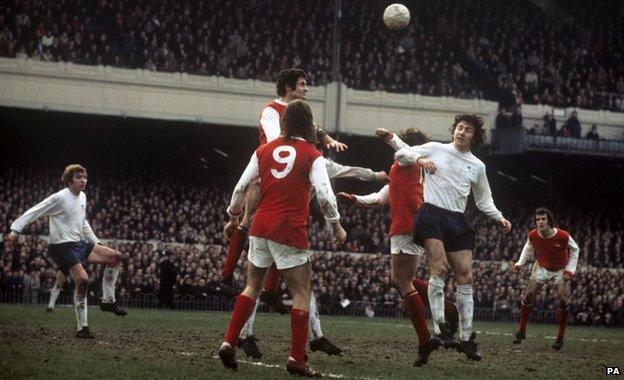
Arsenal achieved the league and FA Cup double in 1971, the year before this photo of a game against Derby
Dr Jeans, 30, a season ticket holder at Chelsea from 1997, said there had been "queues of people" at his gated community since he moved there last year.
"Every home game at the Emirates (Arsenal's new stadium) there are people huddling at the four corners of the (old Highbury) ground.
"When someone comes out, they pile in... You have stewards trying to take people out.
"Before cup finals there are queues of people who come to kiss the old Highbury pitch."

Oxford United: The Manor Ground. Closed in 2001

Manchester United lost at Oxford United in 1986
Oxford United now play in League Two but in the 1980s they were briefly a First Division club.
Matthew Cavill was nine years old when the club put one over Sir Alex Ferguson in his first game in charge of Manchester United at the Manor Ground in 1986.
"Myself and my brother were taken on a whistle-stop tour of the ground," he said.
"(Sir Alex) went 'I'm sorry son, but we're going to ruin your day because we're going to win'. (But) I told him in the room we would win 2-0 and we did."
However, it was the opposite emotion at the final game there against Port Vale in 2001 before the site became The Manor Hospital.
"I was one of the last people to leave the ground. When you have spent so much of (your) life there and then it's gone and we've been relegated, I just felt very empty."
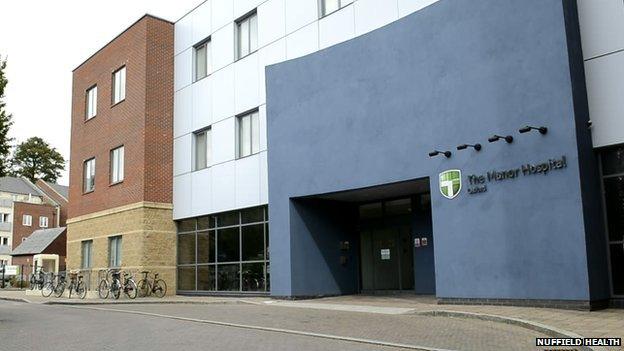
The Manor Hospital, part of not-for-profit healthcare organisation Nuffield Health, is on the old ground site
Mr Cavill, 37, from supporters' trust OxVox, said the Manor Ground was "never very aesthetically pleasing, but it gave off an aura" which the new Kassam Stadium, the club's home since 2001, "has never had".
"(The Manor Ground's) atmosphere was superb. Because it was a small, tiny ground, you felt like with a packed crowd you were about on top of the players and it had a slope which I never appreciated until I got older and played there for my school as a full back.
"The (Kassam Stadium) capacity is over 12,000 and our ground average is about 5,500. It's got an open end, the car park end behind the goal... The noise gets lost."
"The entrance for the London Road End where the main Oxford fans chanted, that's the same as one of the entrances to the hospital. It's a very weird feeling when you walk up there."

Middlesbrough: Ayresome Park. Closed in 1995
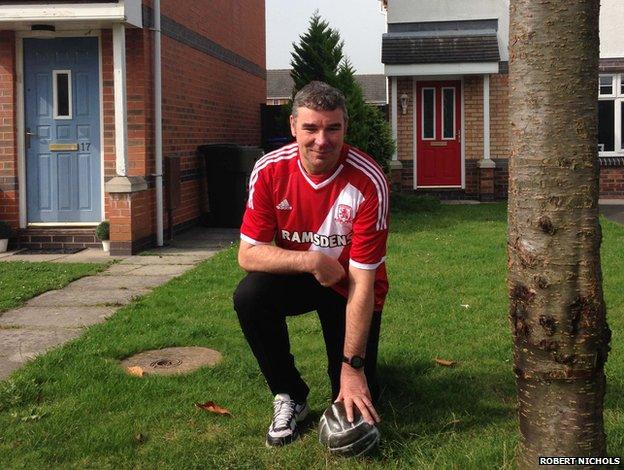
Robert Nichols said in one front garden a sculpture of a football shows where the penalty spot used to be
After Middlesbrough's Ayresome Park ground closed, Robert Nichols, editor of the fanzine Fly Me To The Moon, decided to live in a house built on the site of the former ground.
"I'm just off the pitch. I'm roughly where the Boys End was... where my schoolmates and me watched the matches," he said. "It cost us 50p to get in, which was our pocket money."
Boro's old home is not forgotten, though. About 10 bronze sculptures were made to show where key parts of the ground were.
In one front garden, a sculpture of a football shows where the penalty spot was.
A jumper and a scarf signify two corner flags, while a set of football boots on one doorstep is in the middle of the old centre circle.
"The lady in the house is really proud of them," Mr Nichols, 52, said.
"The other penalty spot is under someone's front room carpet."
Only the vandalised Holgate Wall behind the popular end survives at the site.
He has had visitors from Scandinavia, North Korea and South Korea while giving tours of the site,
"I wanted to live at Ayresome Park, but I chose the best house from my point of view. It's special enough living at Ayresome Park!"

Stoke City: The Victoria Ground. Closed in 1997
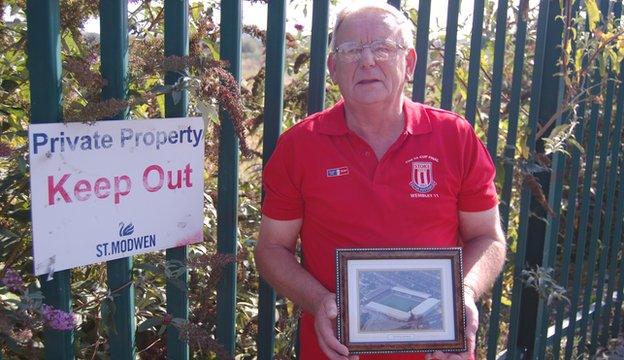
Ian Dodd has gone to Stoke City matches since he was seven years old
"There were grown men who were crying, tears streaming down their faces."
Ian Dodd, 72, remembers the day Sir Stanley Matthews returned to his hometown club in the 1960s, but he first went to the ground aged seven, when "the turnstile guy used to let us younger kids sneak under the barrier".
"If you got there early enough you could sit on the wall which was right on the edge of the pitch, unless you got a particularly stroppy policeman who made you stand behind it," he said.
Mr Dodd, from Clayton, near Newcastle-under-Lyme, also remembered when the Butler Street stand "blew down in a gale" and evidence of the Potteries' industrial heritage - a man "covered in clay, completely white from head to toe".
"He would've come straight from the pot banks... You'd go home and you'd be dusting clay off you where the bloke had been squashed up against you in the stand."
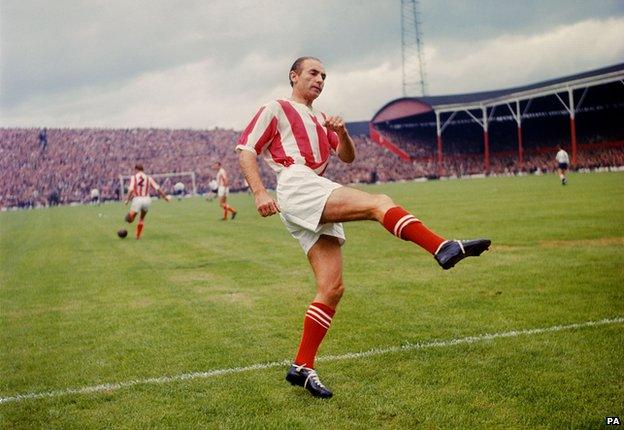
Sir Stanley Matthews, seen warming up in 1963, caused "grown men" to cry, fan Ian Dodd said
Now, though, 17 years after the last game, the site owned by developers St. Modwen is a fenced-off field awaiting planning permission for new housing. The former Stoke City social club opposite the ground's main entrance - at one time a scooter garage - is also derelict.
"Shops suffered... Also the pub on the corner, The Victoria, that shut too.
"It's sad that nothing's been done with the land... It's completely overgrown, there is fencing all around, there is rubbish, dogs running along and fouling, and it's sad to think what went on here years ago and what has happened to it."

Bristol Rovers: Eastville Stadium. Demolished 1998
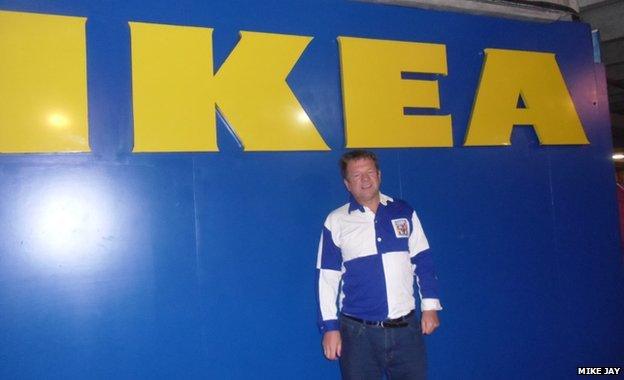
Mike Jay said it was "not that easy" to visualise where the pitch would have been
"I bought a square metre of turf. Me and my son used to play Subbuteo on that piece of grass, when he was growing up - we put it on a paved area on the patio."
Mike Jay, 59, paid about £5 for his slice of Eastville history, while other Bristol Rovers fans bought bulbs from floodlights.
After being inspired by England's World Cup triumph in 1966, he became a Rovers supporter in 1967 and remembers the smell of gas which gave fans the nickname of Gasheads.
"The gas works was immediately behind the Tote End. It was just a whiff of gas... (But) certainly in the evenings you could smell it."
Although Rovers relocated in 1986 and an Ikea store was later built at Eastville, Mr Jay said one floodlight remained near the M32 motorway for many years after the football club had left and the greyhound track around the pitch had gone.

Bristol Rovers played at Eastville until 1986
"In the centre of the store I've tried to visualise where the pitch would have been, but it's not that easy," he said. "The tills are where the North Enclosure was, where I spent most of my time watching.
"You come down the steps to the entrance to Ikea (in the same place as) steps on the way down to where the turnstiles were.
"We would go to a football match rather than go into a Swedish furniture store. It doesn't hold the same excitement for me as going to a football match!"

Southampton: The Dell. Closed in 2001

Nick Illingsworth has visited where the centre spot used to be
Southampton left The Dell in 2001 and the site is now a mixture of houses and flats with apartment blocks named after former players, such as Le Tissier Court, after Matt.
The development follows the shape of the ground, if not the size, with buildings being erected around a central open space, the Ugly Inside fanzine editor Nick Illingsworth, 53, said.
However, the origin of the name Crossley Place, a social housing area where the ground's car park used to be, is unclear.
"The only connection I can find is Matt Le Tissier's only penalty miss was against Nottingham Forest and the goalkeeper was Mark Crossley," said Mr Illingsworth. "Was someone in the developers a Nottingham Forest fan with a bit of a sense of humour?"
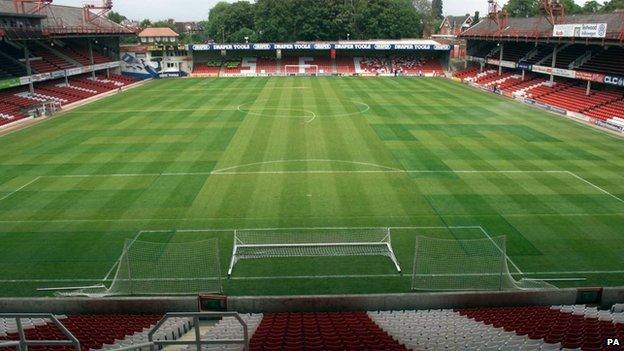
Southampton left The Dell in 2001

The first football match at The Dell was against Brighton and Hove Albion on 3 September 1898

Bolton Wanderers: Burnden Park. Closed in 1997
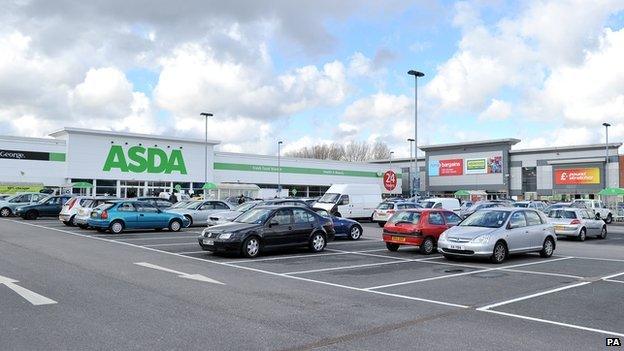
The centre circle is now "part of the car park", Anthony Rearden said
Anthony Rearden, a season ticket holder from the age of three, has lived in Bolton all his life.
The telesales worker watched games from all four sides of the ground and now shops "every other day" at the Asda store where he once stood at the Railway Embankment end behind the goal.
There are about 10 football photos by windows near the checkouts, including pictures of the ground "in its prime" in the 1950s when Nat Lofthouse was banging the goals in, but he feels "sad" going back to the area, he said.
"The people who have never been there would not know there's been a football ground," the 44-year-old said.

Bolton held an auction at their Burnden Park home before moving to a new stadium
There are also stores on the old car park outside the former "Manny" (Manchester) Road stand and on the former Burnden Terrace behind the opposite touchline on the right of the photo.
"It changed the geographical thing of Manchester Road. The pubs down there used to be packed every day.
"(Of) three pubs, two are still there but not run as pubs... (However) the pie shop on Manchester Road is still there. You used to see the players coming out of the pie shop before and after the game."
Additional reporting from Matt Lee